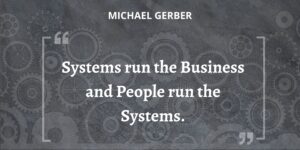
Business Systems: Save YourSelf Time Energy Money and Stress
As a business owner, the daily grind can feel overwhelming. From managing operations to handling client interactions, the workload never seems to lighten. This perpetual pressure often leaves little room to focus on strategic growth. However, there’s a solution that can revolutionise the way you run your business – it’s called S.Y.S.T.E.M.S. (Business Systems).
S.Y.S.T.E.M.S, an acronym for “Save YourSelf Time, Energy, Money, and Stress,” is more than just a buzzword. It’s the key to unlocking your business’s full potential and reclaiming your sanity.
Understanding the Need for Systems: Do you frequently find yourself frustrated by your team’s lack of expertise or overwhelmed by the constant demands on your time? Without efficient systems in place, you’re likely caught in a cycle of chaos. Whether your business is thriving or struggling, the absence of standardised processes can lead to burnout and inefficiency.

How to ‘S.Y.S.T.E.M.S’
To transform your business and alleviate the strain, it’s essential to implement systems across four core areas: People and Education, Delivery and Distribution, Testing and Measuring, and Systems and Technology. By standardising procedures and empowering your team to work autonomously, you can streamline operations and save valuable resources. Start by identifying the tasks each staff member (or even yourself alone) faces daily.
Remember you can introduce systems into your business for almost everything you do.
For example, have a think about the questions your staff ask you the most. Can something be systemised so they can work independently? How many hours will this save you per week?
Then encourage your staff to write down the tasks they do regularly and document the best way to do them. Don’t be afraid to look outside for more information! External aids, such as workshops, can be used to identify the systems which are ideal for your business.
You might ask why do you need all this information?
You need this because it is important that you are able to share effective information, instructions and procedures across your business. Often, an internal website that can be accessed via the cloud is a clever way to store any systems and policies that you have decided on. The information is therefore easily discovered by any staff member at any time.
Implementing Systems
Implementing systems can take some time but you will thank yourself at the end of the process. A great example is improving key processes, for example the way customers should be greeted. You can do this by creating a simple sales script. It may seem like a no-brainer but how else can you ensure each customer receives the same standard of service?
Systems such as these can reduce customer complaints and skyrocket efficiency levels. When you can say “Just follow the system!”, you’ll be free to focus your energy more effectively.
Once you have created systems to save time, energy, money, and stress, stick to them! They won’t do you any good if they are ignored, so offer incentives for staff who are diligent in this area.
The 9 Steps to Business Systems
There are 9 steps to systemising your business, with the end result being a business that can workn without you.
-
Vision statement
The first step towards creating a fully systemised business is setting out a long term vision about the business you’re trying to create – this will help you to design and implement systems that will help you to achieve your final goal.
Write this down, and make sure everyone in your business knows about it.
Take a look at our post on how creating a clear vision benefits your business – link to post for further info on why this is so important.
-
Mission statement
Your mission statement is the road map of how you’re going to achieve your final vision – it sets out who you are, what your business does, who your customers are, and what sets your business apart from the competition.
It shows you, your employees and your customers what you do, and how you’re going to move forward to achieve your goals.
-
Culture statement
Setting out a culture statement helps to create your ‘rules of the game’ – what you stand for, how you work, and the way you do business.
A good culture statement includes things that are important to you, your employees and your customers, as well as elements that will benefit your business as a whole.
-
SMART Goals
Goals are the signposts and milestones that will help you to achieve your vision, and setting SMART (Specific, Measurable, Achievable, Result, Timeframe) based goals will help to keep you focused, and constantly drive your business forward.
Have a look at our post on setting SMART goals – link to post to find out more about how they will benefit your business.
-
Organisation chart
Developing an organisation chart is designed to provide you with a clear picture of your ideal business once it is finished, in terms of the structure, roles and responsibilities, with a box for every role.
If you’re just starting out, you may find that your name would currently appear in virtually every box – and part of systemising and growing your business will be delegating these responsibilities to other people!
-
Positional contracts
Once you’ve created your organisation chart, it’s time to start fleshing it out, by creating positional contracts for every single one of the roles in your ideal organisation – describing the specific responsibilities and tasks involved in each role.
-
KPI’s
The final part of your organisation chart is to set out the key performance indicators for each of the roles you’ve defined, outlining the expectations, and what they need to achieve for your business to be successful.
Doing this will help you to define the steps you need to take, and the people you need to drive your business forward.
-
How to systems
Creating efficient, easy to follow systems will make staff training much easier, and turn good employees into great employees.
Simply put, your how to systems will define exactly how you want each and every employee to complete all the tasks associated with their role.
-
Management systems
The ultimate goal of systemising your business is to create an organisation that works well without you – and putting management systems in place to handle the day to day running of your business is the final piece of the puzzle.
The Benefits of Effective Systems
By embracing S.Y.S.T.E.M.S, you can cultivate a business that operates seamlessly, even in your absence. As your team adheres to standardised procedures, you’ll experience increased efficiency, reduced stress, and greater profitability. Moreover, by continuously refining your systems, you can adapt to changing circumstances and drive sustainable growth.
One final point is that systems can be constantly tweaked to improve efficiency and save your business more money. So any system you start does not need to be set in stone. Some may even end up being redundant as your organisation evolves.
How do you know when your systems are working? You’ll be able to step away from your business and have it run without you. There will be no need for micromanaging or constant interruptions from your staff; because they’re saving time, you’re saving money. And this means you can finally afford some time off!
Reach out to us today to learn more about how S.Y.S.T.E.M.S can revolutionise your business. We’re here to help you succeed every step of the way.


